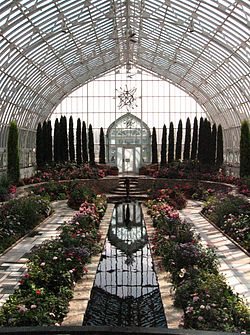Como Park Zoo and Conservatory
| Como Park Zoo and Marjorie McNeely Conservatory | |
|---|---|

The Marjorie McNeely Conservatory at Como Park
|
|
| Type | Urban park |
| Location | Saint Paul, Minnesota |
| Coordinates | 44°58′53″N 93°09′03″W / 44.981397°N 93.150807°WCoordinates: 44°58′53″N 93°09′03″W / 44.981397°N 93.150807°W |
| Area | 759 acres (307 ha) |
| Created | 1873 |
| Visitors | about 1.9 million annually |
| Status | Open all year |
|
Como Park Conservatory
|
|

The sunken garden in the Marjorie McNeely Conservatory
|
|
| Location | Como Park St. Paul, Minnesota |
|---|---|
| Built | 1913 |
| Architect | Frederick Nussbaumer |
| NRHP reference # | 74001033 |
| Added to NRHP | November 19, 1974 |
The Como Park Zoo and Marjorie McNeely Conservatory (or just Como Zoo and Conservatory) are located in Como Park at 1225 Estabrook Drive, Saint Paul, Minnesota. The park, zoo and conservatory are owned by the City of Saint Paul and are a division of Saint Paul Parks and Recreation. The attractions located there include the zoo, the conservatory, an amusement park, a carousel, Lake Como, a golf course, a pool and more. The park receives more than 1.9 million visitors annually. Como Park is a free park and while no admission fee is charged for the zoo or conservatory, voluntary donations of $3 per adult and $2 child are suggested.
In 1873 the City of Saint Paul acquired 300 acres (120 ha) of land around Como Lake that would become a public park. Today the 384-acre (155 ha) park includes:
In 1939 Lake Como hosted the Winter Carnival Ice Palace and the Winter Carnival Medallion has been hidden in Como Park eight times (1956, 1965, 1980, 1990, 1997, 2001, 2003, and 2014).
The first zoo in Saint Paul was on Harriet Island when in 1897, the city of St. Paul received a gift of three deer. Additional animals followed, when more room was needed to house the animals they were moved to facilities at Como Park. Como Zoo continued to grow through donations of animals and money.
The Art Deco Zoological Building was designed in 1936 by Charles Bassford as part of the federally funded Works Progress Administration. Other WPA structures were completed in the 1930s, including Monkey Island (now Seal Island), barn and bear grotto.
In the 1980s several new exhibits were added as part of a major renovation project, including the Large Cat exhibit (1980), Aquatic Animal Building and conversion of Monkey Island to Seal Island (1982), the Primate Facility (1985), the Land and Water Bird exhibit (1986) and the African Hoofed Stock Facility (1987).
A new Polar bear exhibit was finished in 2010. The two twin Polar bear brothers (Buzz and Neil) returned from their temporary stay in Canada. The exhibit includes a shallow and deep pool plus a middle room. It also has a back room where the Polar bears can choose to stay in the AC.
...
Wikipedia
